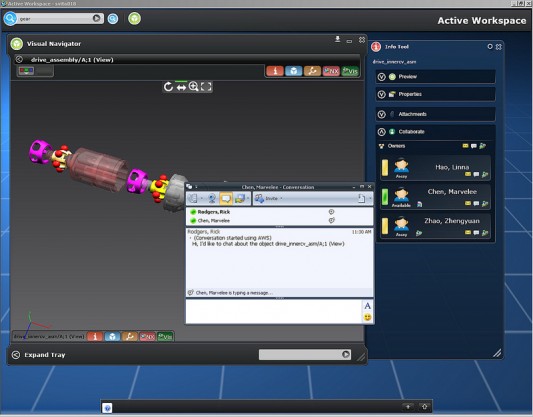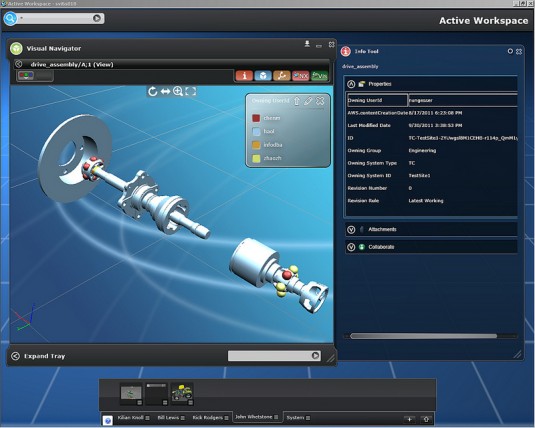Increased product complexity requires new strategies to keep engineering and manufacturing manageable. Active Workspace visualizes relationships and exposes information in an integrated fashion.
“Big data” is a hot topic lately. Recently the White House Office of Science and Technology announced it has launched a new initiative to “advance state-of-the-art core technologies needed to collect, store, preserve, manage, analyze, and share huge quantities of data.” The PLM industry didn’t need a White House initiative to know it needed to do a better job of revealing product data from a variety of sources in a useful way.

Recently Siemens PLM Software introduced a new feature to its PLM portfolio called Active Workspace (AW), a visual and personalized search and collaboration environment for instantly accessing intelligent 3D information. It goes beyond NX, Siemens PLM’s enterprise 3D CAD, by visualizing data and relationships resident in its Teamcenter PLM data management system. Siemens PLM says Active Workspace is another step towards realizing its vision of High Definition PLM (HD-PLM), which the company first articulated in 2010 as its roadmap to improving its PLM portfolio.
Siemens PLM started talking about HD-PLM to explain to its customers how it would be extending the capabilities of its PLM software to cope with ever-increasing complexity; Active Workspace is a tool that implements the vision. In essence, AW mines all the data about a product and visually organizes it for the end user.
Three key points
Siemens PLM says there are three key points that guided the development of Active Workspace:
Intelligently integrated information: A requirements document and a CAD model are two very different repositories of data, but they are both important to the design and manufacturing of a product. At any given time during product development an engineer may need to refer to or create information in both, but it is usually the norm that the data in each place was created by different people. If a requirement changes, the CAD model must change. Active Workspace is designed to track and display the semantics of such relationships and to visualize them.
Future-proof architecture: Siemens PLM says it realizes manufacturers don’t use only their products, and that they upgrade their software on a schedule that fits their workflow, not the product release cycle of a software company. By design, Active Workspace accepts data from other software products, not just from Siemens PLM products, and it is designed to be upgraded without disrupting previously created semantic relationships between data from various software environments.
HD user experience: Siemens want the user experience to vary with the person and the role they fill. As Bill Lewis, Teamcenter marketing manager for Active Workspace, says, “a designer, a purchaser, a buyer should all feel as if the tool was made just for them.”

Active Workspace in use
When installed, Active Workspace starts by indexing all the various sources of information relating to one particular product or project. The goal is for Active Workspace to become the single place to go to find information. Lewis says the setup process is more like question-and-answer than most traditional PLM products, because AW needs to know how existing data sources fit into the larger scheme of the product. “It is not so much a technology challenge as it is a business process challenge,” Lewis says.
AW is not an authoring environment; a user won’t use it to create a Bill of Materials or other reports. Instead, it is a gateway to the information needed to generate those reports. A user would still use the existing primary authoring tool.
Active Workspace is designed to give users a visual method of working with networks of information. For example, if a user wants to replace a part and find a new bracket, AW would show the bracket and the links to all the information about it, including the people who are responsible for that part of the product. Thus AW becomes a collaboration tool, by linking the people responsible in any given situation, not just the data. AW is designed to show stakeholders as part of the product data ecosystem, and to connect users as part of the AW interface.
A less rigid approach to visual navigation
Siemens PLM was not the first to offer a visual approach to navigating the complexities of product development data; Dassault Systèmes also offers such a system as part of its V6 product development platform. Siemens PLM has taken a “naming the spoon” approach to adding visual navigation to its PLM system, because it does not want to subject its user base to the kind of rigid upgrade decision process Dassault requires. Active Workspace users can be on various releases of Teamcenter, and be using a variety of software from other vendors. This is a key differentiator from the Dassault approach, which makes it hard to blend software tools from a variety of sources.






